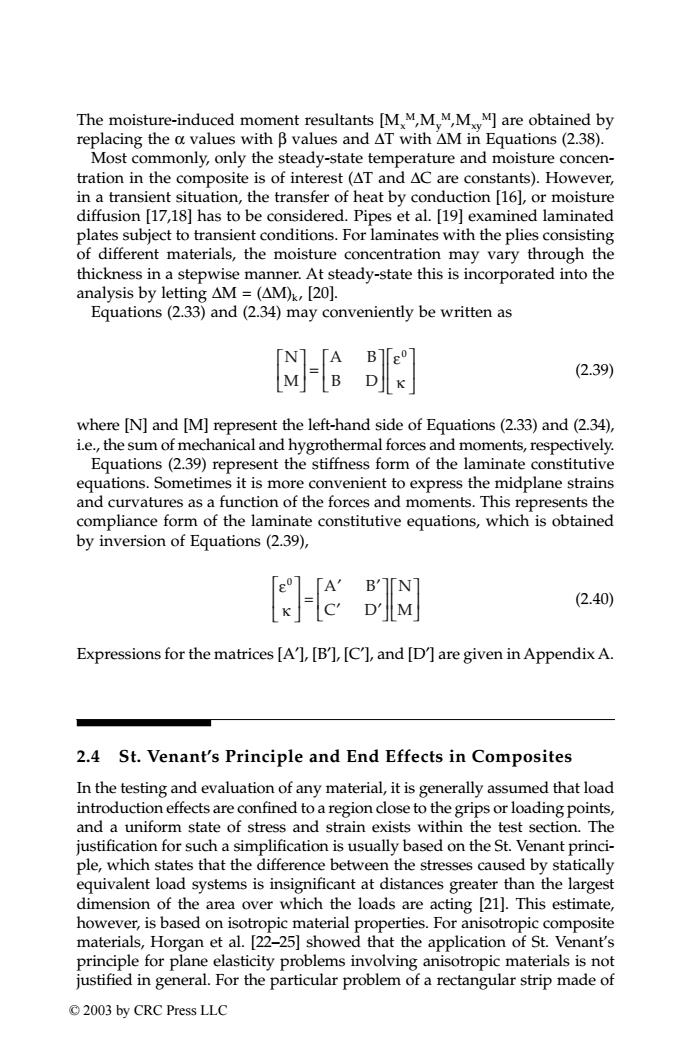正在加载图片...

The moisture-induced moment resultants [MMM,M,MM]are obtained by replacing the a values with B values and AT with AM in Equations(2.38). Most commonly,only the steady-state temperature and moisture concen- tration in the composite is of interest (AT and AC are constants).However, in a transient situation,the transfer of heat by conduction [16],or moisture diffusion [17,18]has to be considered.Pipes et al.[19]examined laminated plates subject to transient conditions.For laminates with the plies consisting of different materials,the moisture concentration may vary through the thickness in a stepwise manner.At steady-state this is incorporated into the analysis by letting AM=(AM)k,[20]. Equations(2.33)and(2.34)may conveniently be written as 6 (2.39) where [N]and [M]represent the left-hand side of Equations(2.33)and (2.34), i.e.,the sum of mechanical and hygrothermal forces and moments,respectively. Equations(2.39)represent the stiffness form of the laminate constitutive equations.Sometimes it is more convenient to express the midplane strains and curvatures as a function of the forces and moments.This represents the compliance form of the laminate constitutive equations,which is obtained by inversion of Equations(2.39), (2.40) Expressions for the matrices [A],[B'],[C],and [D]are given in Appendix A. 2.4 St.Venant's Principle and End Effects in Composites In the testing and evaluation of any material,it is generally assumed that load introduction effects are confined to a region close to the grips or loading points, and a uniform state of stress and strain exists within the test section.The justification for such a simplification is usually based on the St.Venant princi- ple,which states that the difference between the stresses caused by statically equivalent load systems is insignificant at distances greater than the largest dimension of the area over which the loads are acting [21].This estimate, however,is based on isotropic material properties.For anisotropic composite materials,Horgan et al.[22-25]showed that the application of St.Venant's principle for plane elasticity problems involving anisotropic materials is not justified in general.For the particular problem of a rectangular strip made of ©2003 by CRC Press LLCThe moisture-induced moment resultants [Mx M,My M,Mxy M] are obtained by replacing the α values with β values and ∆T with ∆M in Equations (2.38). Most commonly, only the steady-state temperature and moisture concentration in the composite is of interest (∆T and ∆C are constants). However, in a transient situation, the transfer of heat by conduction [16], or moisture diffusion [17,18] has to be considered. Pipes et al. [19] examined laminated plates subject to transient conditions. For laminates with the plies consisting of different materials, the moisture concentration may vary through the thickness in a stepwise manner. At steady-state this is incorporated into the analysis by letting ∆M = (∆M)k, [20]. Equations (2.33) and (2.34) may conveniently be written as (2.39) where [N] and [M] represent the left-hand side of Equations (2.33) and (2.34), i.e., the sum of mechanical and hygrothermal forces and moments, respectively. Equations (2.39) represent the stiffness form of the laminate constitutive equations. Sometimes it is more convenient to express the midplane strains and curvatures as a function of the forces and moments. This represents the compliance form of the laminate constitutive equations, which is obtained by inversion of Equations (2.39), (2.40) Expressions for the matrices [A′], [B′], [C′], and [D′] are given in Appendix A. 2.4 St. Venant’s Principle and End Effects in Composites In the testing and evaluation of any material, it is generally assumed that load introduction effects are confined to a region close to the grips or loading points, and a uniform state of stress and strain exists within the test section. The justification for such a simplification is usually based on the St. Venant principle, which states that the difference between the stresses caused by statically equivalent load systems is insignificant at distances greater than the largest dimension of the area over which the loads are acting [21]. This estimate, however, is based on isotropic material properties. For anisotropic composite materials, Horgan et al. [22–25] showed that the application of St. Venant’s principle for plane elasticity problems involving anisotropic materials is not justified in general. For the particular problem of a rectangular strip made of N M A B B D = ε κ 0 ε κ 0 ′ ′ ′ ′ = A B C D N M TX001_ch02_Frame Page 23 Saturday, September 21, 2002 4:48 AM © 2003 by CRC Press LLC